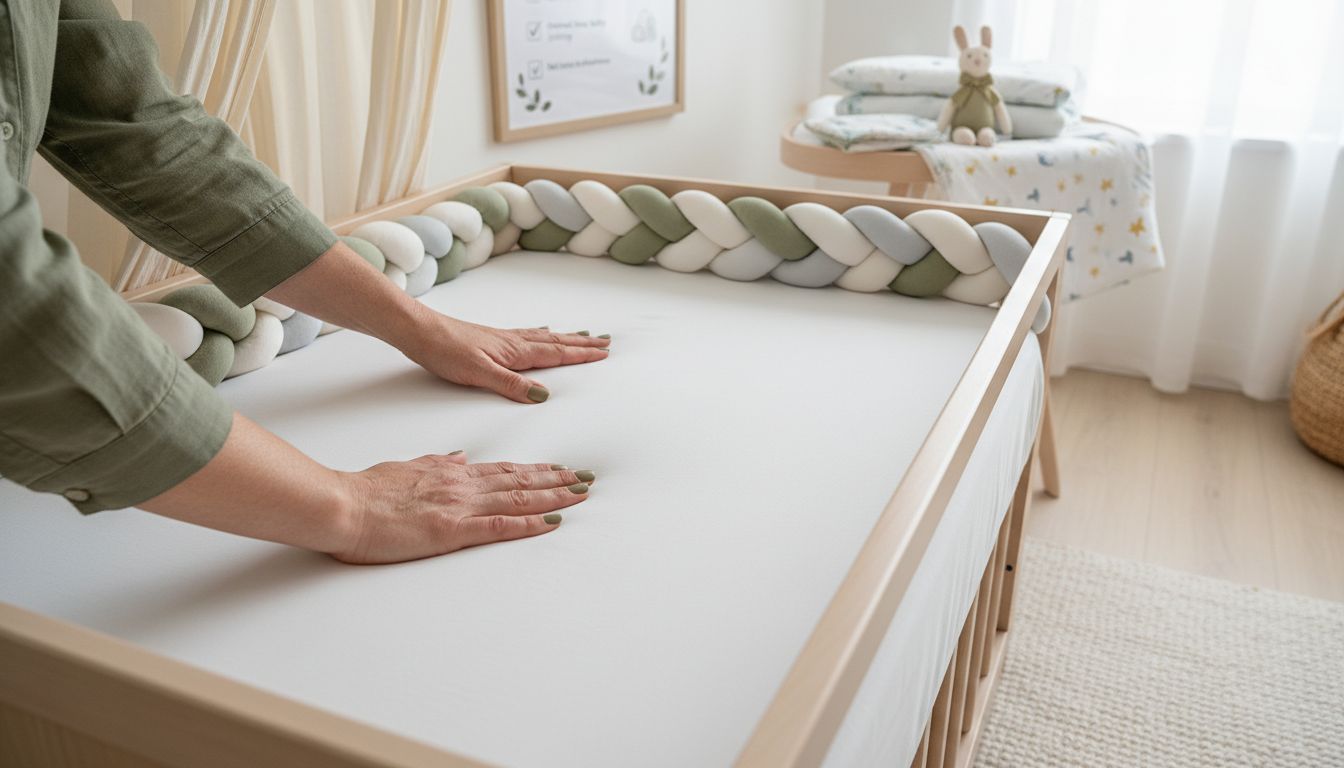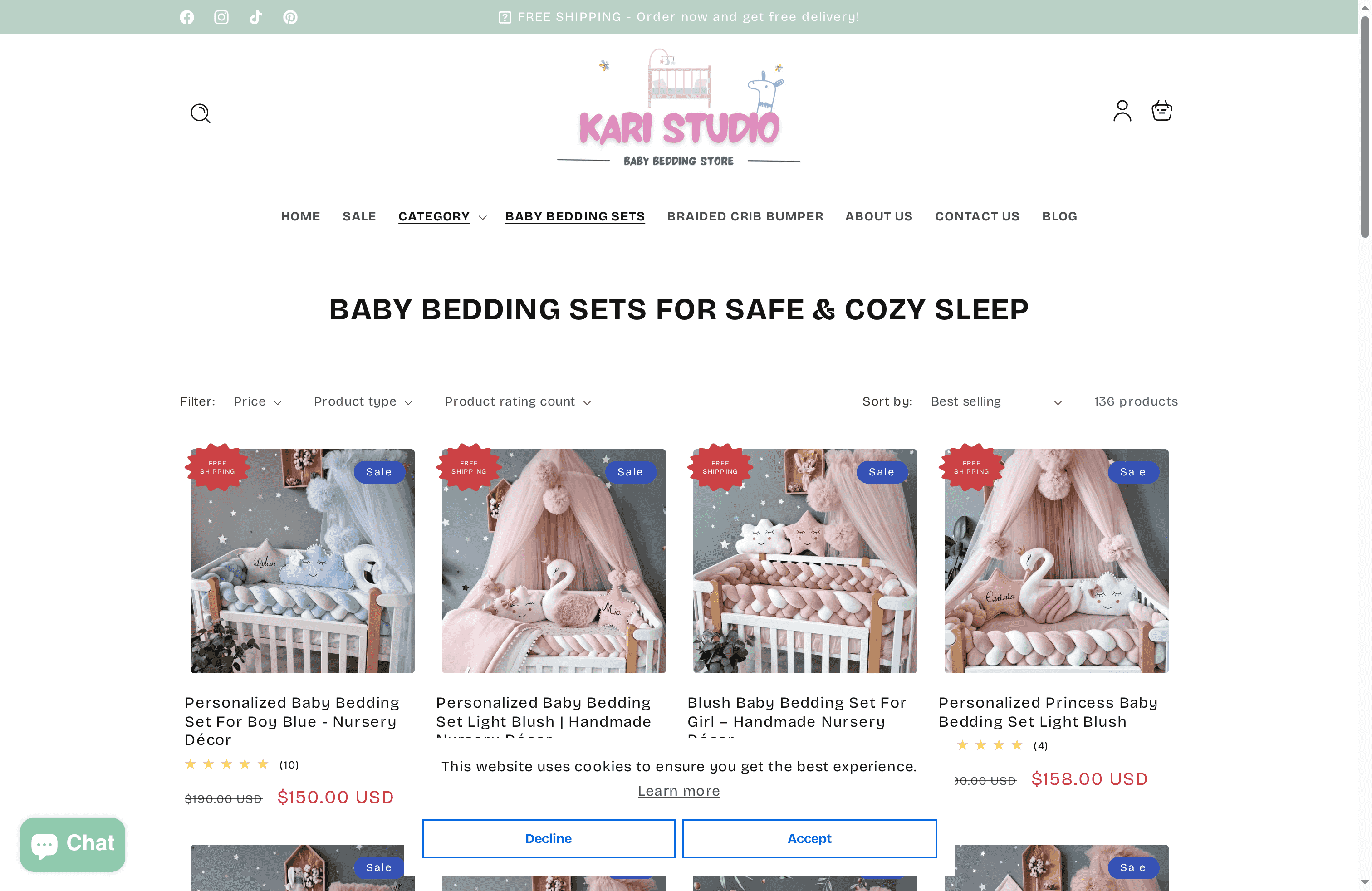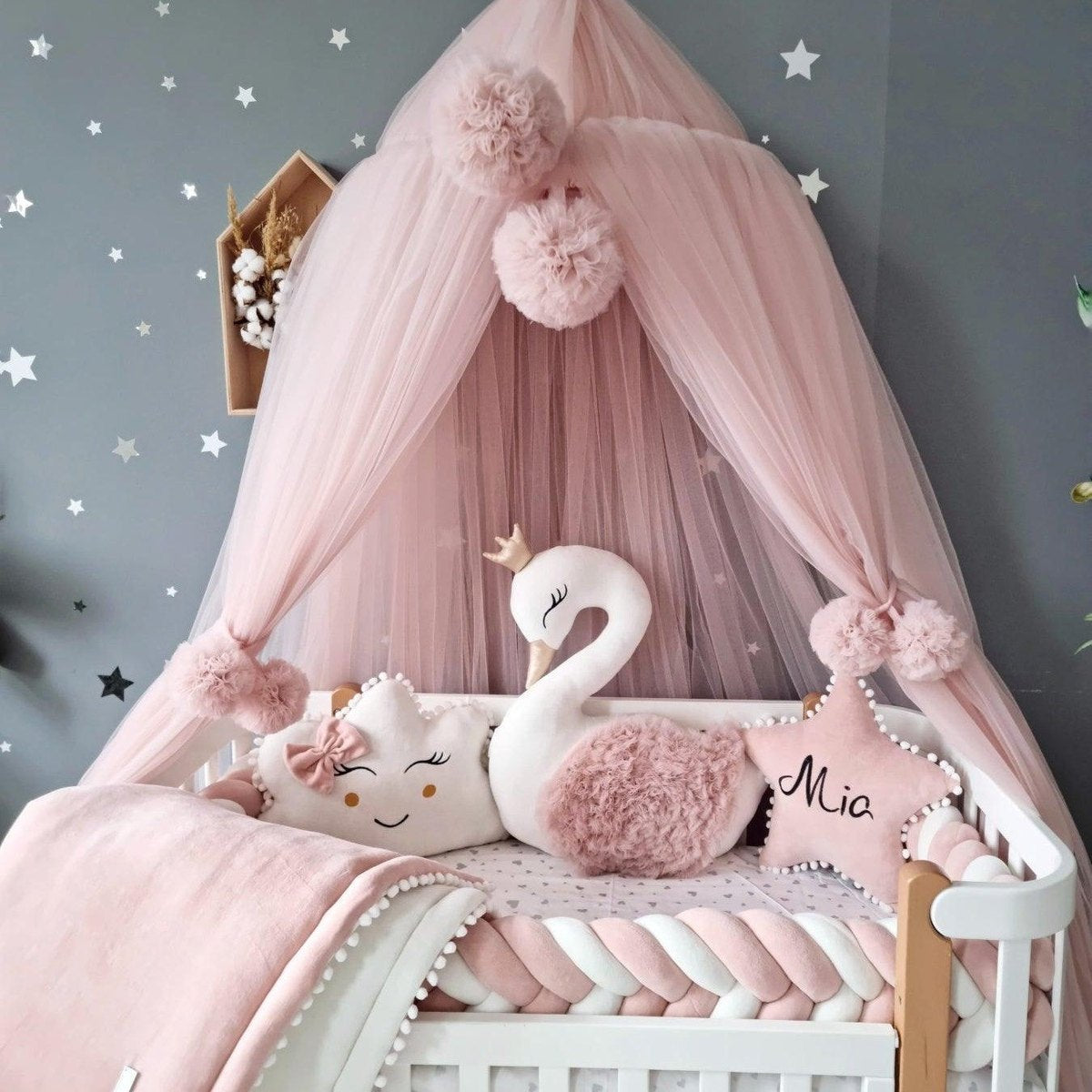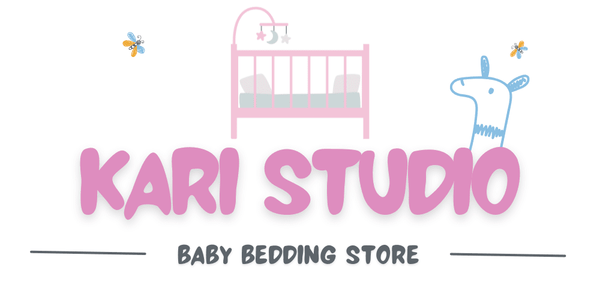Más de 3500 bebés estadounidenses mueren cada año por incidentes relacionados con el sueño, un recordatorio esclarecedor de que la seguridad en la habitación del bebé es más que una simple moda. Todos los padres desean que su bebé tenga el comienzo más seguro, y elegir la cuna adecuada puede marcar la diferencia. Esta guía le muestra pasos claros y comprobados para crear un espacio de sueño seguro y tranquilo, ayudándole a proteger a su hijo y a dormir mejor.
Tabla de contenido
- Paso 1: Elija materiales seguros para el colchón y la ropa de cama
- Paso 2: Instale las sábanas ajustables y verifique la firmeza del colchón
- Paso 3: Evite colocar almohadas, mantas o juguetes dentro de la cuna
- Paso 4: Seleccione y coloque los protectores de cuna adecuados (use trenzas Kari Studio)
- Paso 5: Revise las barandillas y asegure todos los componentes de la cuna
- Paso 6: Complete la lista de verificación de seguridad final para su tranquilidad
Resumen rápido
| Visión clave | Explicación |
|---|---|
| 1. Elija un colchón de cuna firme | Un colchón firme se ajusta perfectamente a la cuna, lo que reduce el riesgo de asfixia o atrapamiento de su bebé. |
| 2. Evite la ropa de cama y los juguetes blandos. | Mantenga la cuna vacía, sin almohadas ni mantas, para evitar riesgos de asfixia y reducir los riesgos de SMSL. |
| 3. Utilice correctamente las sábanas ajustables | Asegúrese de que las sábanas ajustables sean ajustadas y específicas para las dimensiones del colchón de la cuna para evitar áreas sueltas durante el sueño. |
| 4. Inspeccione periódicamente los componentes de la cuna | Las revisiones mensuales de las barandillas y los herrajes mantienen la cuna segura y libre de posibles riesgos de seguridad. |
| 5. Complete una lista de verificación de seguridad | Una revisión final de la guardería garantiza que se implementen todas las medidas de seguridad, creando un entorno de sueño seguro. |
Paso 1: Elija materiales seguros para el colchón y la ropa de cama
Al crear una habitación infantil segura, seleccionar el colchón y la ropa de cama adecuados es crucial para la protección de su bebé. La Comisión de Seguridad de Productos del Consumidor (CPSC) ofrece directrices claras para ayudar a los padres a crear un entorno de sueño seguro.
El colchón de la cuna de su bebé debe ser firme y ajustarse perfectamente al marco de la cuna. Según laComisión de Seguridad de Productos del Consumidor (CPSC) , no debe haber espacios entre el colchón y los laterales de la cuna que puedan atrapar extremidades pequeñas o crear riesgo de asfixia. Busque colchones diseñados específicamente para cunas de bebés, que son significativamente más firmes que los colchones estándar para adultos.
Los materiales de cama requieren una selección igualmente cuidadosa. La regla clave es el minimalismo. MedlinePlus recomienda encarecidamente no usar ropa de cama blanda como almohadas, edredones, cubrecamas o pieles de oveja en la cuna. Estos artículos pueden representar un peligroso riesgo de asfixia para los bebés. En su lugar, opte por una sábana ajustable que se ajuste exactamente a las dimensiones del colchón.
Consejo profesional: Al comprar ropa de cuna, priorice siempre la seguridad sobre la estética. Elija materiales transpirables e hipoalergénicos y evite accesorios sueltos o abultados que puedan tapar la cara de su bebé mientras duerme.
Al seguir estas pautas, está dando pasos cruciales para crear un entorno de sueño seguro para su pequeño. Su siguiente objetivo debe ser asegurar el montaje y la colocación correctos de la cuna.
Paso 2: Instale las sábanas ajustables y verifique la firmeza del colchón
Ahora que ha elegido un colchón seguro, es hora de preparar adecuadamente la cuna para su pequeño. El objetivo es crear una superficie de descanso segura y cómoda que minimice los posibles riesgos.
Johns Hopkins Medicine enfatiza la importancia crucial de usar una sábana ajustable que se ajuste perfectamente a su colchón. Al colocar la sábana, asegúrese de que quede bien ajustada sobre el colchón, sin zonas sueltas ni arrugadas. La Comisión de Seguridad de Productos del Consumidor recomienda usar únicamente sábanas diseñadas específicamente para colchones de cuna para garantizar un ajuste cómodo y seguro.
Para verificar la firmeza del colchón, realice una prueba sencilla. Presione con la mano el centro del colchón y suéltelo. Un colchón infantil adecuado debería recuperar rápidamente su posición original sin dejar marcas. Los colchones blandos o hundidos pueden crear condiciones peligrosas para dormir, ya que el bebé podría hundirse en la superficie, lo que podría dificultar su respiración.

Consejo profesional: Tenga siempre sábanas ajustables de repuesto a mano y reemplácelas inmediatamente si se desgastan, se estiran o pierden su firmeza. Inspeccione regularmente el colchón y las sábanas para mantener un ambiente de descanso seguro.
Con las sábanas ajustables colocadas de forma segura y la firmeza del colchón confirmada, estás un paso más cerca de crear una habitación de bebé segura para tu bebé.
Paso 3: Evite colocar almohadas, mantas o juguetes dentro de la cuna
Crear un ambiente de sueño seguro implica comprender qué no debe estar en la cuna de tu bebé. Los objetos suaves pueden parecer acogedores, pero representan graves riesgos para la seguridad del bebé.
Según la Comisión de Seguridad de Productos del Consumidor , la cuna debe permanecer completamente vacía para reducir el riesgo de asfixia y prevenir el síndrome de muerte súbita del lactante (SMSL). Healthy Children de la Academia Americana de Pediatría refuerza esta recomendación advirtiendo explícitamente a los padres que mantengan los objetos blandos y la ropa de cama suelta fuera del área de descanso del bebé.
Esto significa retirar todos los artículos potencialmente peligrosos, como peluches, almohadas suaves, mantas gruesas, protectores de cuna y cojines decorativos. Incluso las mantas ligeras pueden cubrir accidentalmente la cara del bebé y dificultarle la respiración. El único artículo que debe estar en la cuna es una sábana ajustada diseñada específicamente para colchones infantiles.
Consejo profesional: si le preocupa que su bebé pase frío, vístalo con ropa de dormir adecuada, como un saco de dormir portátil o un mono liviano, en lugar de agregar ropa de cama adicional.
Al mantener un enfoque minimalista en el espacio para dormir de su bebé, reduce significativamente los peligros potenciales y crea un entorno más seguro para un descanso tranquilo.
Paso 4: Seleccione y coloque los protectores de cuna adecuados (use trenzas Kari Studio)
Navegar por el mundo de la seguridad de las cunas puede ser confuso, especialmente cuando se trata de elementos decorativos como protectores. Si bien se desaconsejan totalmente los protectores tradicionales, Kari Studio ofrece una alternativa más segura con su innovador diseño trenzado.
La Comisión de Seguridad de Productos del Consumidor advierte explícitamente contra el uso de protectores de cuna tradicionales debido al riesgo de asfixia y atrapamiento. Healthy Children, de la Academia Americana de Pediatría, refuerza esta recomendación, afirmando que no existe evidencia que respalde la seguridad de los protectores de cuna.
Los protectores trenzados Kari Studio ofrecen una solución única. A diferencia de los protectores acolchados tradicionales, estos diseños trenzados transpirables minimizan los posibles riesgos y aportan un toque decorativo. Al instalarlos, asegúrese de que el trenzado esté bien sujeto y no deje huecos ni zonas sueltas que puedan suponer un riesgo para su bebé.
Consejo profesional: coloque siempre los protectores trenzados lejos de la cara de su bebé y siga las pautas de instalación específicas del fabricante para mantener la máxima seguridad.
Recuerde que incluso con diseños más seguros, el objetivo principal es crear un entorno de sueño minimalista que priorice la protección de su bebé.
Paso 5: Revise las barandillas y asegure todos los componentes de la cuna
Garantizar la integridad estructural de la cuna de su bebé es una medida de seguridad fundamental que requiere una inspección exhaustiva y sistemática. Su objetivo es crear un entorno seguro que evite posibles accidentes y le brinde tranquilidad.
Según la Comisión de Seguridad de Productos del Consumidor, es fundamental examinar minuciosamente todos los componentes de la cuna para detectar herrajes faltantes, sueltos o rotos. MedlinePlus refuerza esta guía recomendando revisiones de seguridad periódicas para prevenir el riesgo de atrapamiento.
Comience por las barandillas. Verifique que estén bien sujetas y que se puedan subir y bajar con suavidad y sin tambalearse. Revise cada tornillo y soporte para asegurarse de que estén bien fijados. Preste especial atención a la zona de apoyo del colchón. Al presionar, el soporte debe sentirse estable y no moverse ni crujir.
Consejo profesional: Inspeccione su cuna mensualmente. Los bebés crecen rápido y pueden volverse más activos, lo que podría aflojar componentes que antes estaban seguros. Consulte nuestra guía completa sobre la protección de las barandillas de la cuna para obtener más información sobre cómo mantener un entorno de sueño seguro.
Una inspección exhaustiva ahora puede prevenir posibles problemas de seguridad y brindar un espacio seguro para que su pequeño descanse y crezca.
Paso 6: Complete la lista de verificación de seguridad final para su tranquilidad
Una vez completados todos los pasos de seguridad, ya está listo para realizar una revisión final exhaustiva del entorno de la habitación de su bebé. Esta inspección final crucial garantiza que cada detalle contribuya a la seguridad y comodidad de su bebé.
La Comisión de Seguridad de Productos del Consumidor (CPSC) ofrece una lista de verificación de seguridad detallada para ayudar a los padres a verificar la configuración de la habitación de su bebé. Healthy Children refuerza estas directrices haciendo hincapié en la revisión exhaustiva de los espacios para dormir.
Su lista de verificación final debe incluir verificar que el colchón sea firme y se ajuste bien, que todos los herrajes estén bien fijados, que no haya objetos blandos en la cuna, que los enchufes estén cubiertos y que no exista peligro de estrangulación con cables o cortinas. Recorra toda la habitación del bebé y evalúe los posibles riesgos desde diferentes ángulos.
Consejo profesional: Toma fotografías de tu configuración final. Esto te permitirá revisar y documentar tus precauciones de seguridad y te servirá como referencia para futuros ajustes.
Al trabajar metódicamente con esta lista de verificación de seguridad final, está creando un santuario de protección para su pequeño más preciado.
![]()
Cree una habitación infantil segura y elegante con confianza
Equipar la cuna de tu bebé con la ropa de cama y los accesorios adecuados es crucial para evitar errores de seguridad comunes, como sábanas sueltas, peluches o protectores de cuna inseguros. En Kari Studio, entendemos tu preocupación por crear una habitación infantil segura y acogedora que cumpla con todas las normas de seguridad y refleje tu estilo personal. Nuestros artículos esenciales para la habitación del bebé, hechos a mano, se centran en la comodidad y la protección, utilizando telas hipoalergénicas, seguras y suaves, diseñadas específicamente para bebés.

Explora nuestros juegos de cama para bebé, cuidadosamente elaborados, para encontrar sábanas firmes y ajustables, además de artículos transpirables y personalizables que fomentan un sueño seguro. Elige entre protectores de cuna trenzados y protectores de barandilla que añaden una capa de protección suave sin comprometer la seguridad de tu bebé. Actúa ahora para prevenir riesgos y convertir la habitación de tu pequeño en un santuario visitando la colección de Kari Studio y seleccionando piezas de confianza y calidad que brindan tranquilidad y comodidad duradera.
Preguntas frecuentes
¿Cuáles son los errores más comunes que se deben evitar al instalar una cuna?
Evite usar ropa de cama blanda, como almohadas o mantas, en la cuna de su bebé. En su lugar, use una sábana ajustable y asegúrese de que la cuna permanezca vacía para minimizar el riesgo de asfixia.
¿Cómo puedo garantizar que el colchón de mi bebé sea seguro?
Pruebe la firmeza del colchón presionando con la mano y asegurándose de que recupere su forma rápidamente sin dejar marcas. Si lo siente blando o hundido, reemplácelo por uno más firme, diseñado para bebés.
¿Qué debo comprobar durante una inspección de seguridad de la cuna?
Inspeccione regularmente todos los componentes de la cuna, incluyendo barandillas, tornillos y soportes, para detectar cualquier holgura o daño. Realice estas revisiones mensualmente para garantizar que el entorno de descanso de su bebé se mantenga seguro.
¿Por qué los protectores de cuna tradicionales suponen un riesgo para la seguridad?
Los protectores de cuna tradicionales pueden presentar riesgos de asfixia y atrapamiento. En su lugar, considere usar protectores trenzados, diseñados para ser más seguros y, al mismo tiempo, darle un toque decorativo a la cuna.
¿Cómo puedo crear un espacio de sueño seguro para mi bebé?
Mantenga la cuna libre de objetos blandos y asegúrese de que el colchón quede bien ajustado y sin huecos. Limite el espacio para dormir de su bebé a solo una sábana ajustable para mayor seguridad y reducir el riesgo de síndrome de muerte súbita del lactante (SMSL).
¿Cuál es una lista de verificación de seguridad final para la instalación de una cuna?
Verifique la firmeza del colchón, asegúrese de que todos los herrajes estén bien fijados y confirme que no haya objetos blandos en la cuna. Recorra la habitación del bebé para detectar posibles peligros, como cables sueltos o enchufes sin protección.

